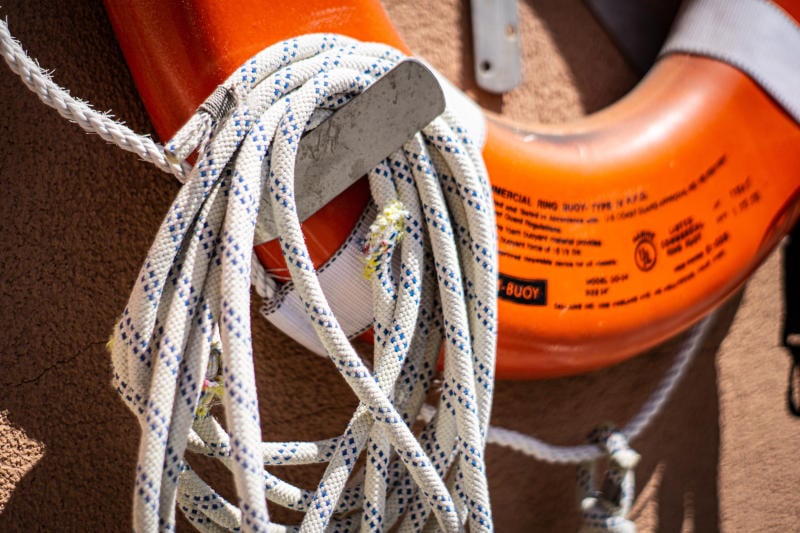A person who is drowning is in extreme danger and must be rescued immediately. However, the signs of drowning aren’t as obvious as you might think, and all too often people who attempt to rescue a drowning victim end up becoming victims themselves in the process.
According to the World Health Organization, “drowning is the third leading cause of unintentional injury death worldwide, accounting for 7% of all injury-related deaths.” By learning how to recognize the warning signs and respond when a person is drowning, you can help prevent more unnecessary deaths.
Read on to learn how to recognize the signs of drowning and how to rescue a drowning victim without endangering yourself or others.
What Is Drowning?
A person who is drowning is experiencing suffocation from submersion in liquid. Often, this happens in large bodies of water, such as pools, rivers, lakes, or the ocean, but a person can drown in as little as a few inches of water. While drowning can be fatal, it can also be nonfatal and with or without long-term injuries.
Unlike in dramatic drowning scenes in movies or television shows, when a person is drowning, they are usually unable to call for help or make wild movements in the water. Instead, signs of drowning are often quiet.
According to Stop Drowning Now, a person who is drowning may:
- Be motionless or facedown in the water
- Appear to swim without making progress
- Keep their head down or tilted back with hair covered their face or eyes
- Have a look of doom or fear in their eyes
- Jump or dive into the water but fail to come back up quickly
Additionally, a drowning person’s mouth often bobs in the water, and they may instinctively try to press down on the water’s surface with their arms. A person who is drowning will most likely not be able to respond to questions, ask for help, or assist with their own rescue.
How Do You Save Someone Who Is Drowning?
Once a person shows signs of drowning, there is very little time left in which to rescue them. That said, do not jump into the water to save a drowning person unless you have been specifically trained to do so and you are certain that it is safe.
A person who is drowning will panic and grab onto anything they can — including an intended rescuer. The last thing you want is for them to drag you down under the water with them.

Instead, if the person is close enough, throw or extend a lifesaving device, rope, or sturdy pole for the person to grab onto and pull them to safety. If they are too far for you to reach without entering the water, get help from a trained lifeguard instead of attempting to rescue them on your own.
How Do You Administer CPR on a Drowning Victim?
If a person has been rescued after exhibiting signs of drowning and is not breathing, you’ll need to begin CPR immediately.
While compression-only CPR is often recommended for untrained lay rescuers in other instances of cardiac arrest, drowning is different. When a person is drowning, their body is unable to maintain a regular flow of oxygen to their brain, so it’s vital to restore their oxygen flow as quickly as possible.
When administering CPR on a drowning victim, clear their airway and begin rescue breathing as soon as you can. If it is safe to do so, you can give the first few rescue breaths as soon as you reach shallow water or a stable surface.
Then continue performing CPR, alternating chest compressions and rescue breathing until medical professionals arrive or the person begins breathing normally again. If the person vomits, roll them onto their side so they will not choke and then clear the airway and resume CPR if they are still not breathing normally.
How Do You Prevent Drowning?
With proper safety precautions, drowning is preventable. Here are some of the best drowning prevention actions you can take to protect yourself and your loved ones:
- Educate yourself and others to recognize the signs of drowning and of potentially dangerous water conditions
- Always wear a life jacket when boating or participating in water sports
- Make sure there is a trained lifeguard on duty when you or your loved ones are swimming
- Closely supervise children at all times near water — even if it’s shallow
- Do not consume alcohol before or while swimming or boating
Remember, drowning can happen within seconds, and it’s often silent. Stay alert, and never leave children or infants unattended in or near water.
Do You Know the Signs of Drowning?
Drowning is a serious emergency that can lead to death very quickly, so it’s essential to recognize the signs of drowning and be able to provide immediate aid both safely and effectively.
Never endanger yourself while trying to rescue someone who is drowning. If attempting a rescue would put you at risk, the best thing you can do is get help from a trained professional who can rescue the drowning victim without putting themselves or anyone else in harm’s way.
Contact us today to learn more about our group and remote-staff CPR online training and certification programs.
